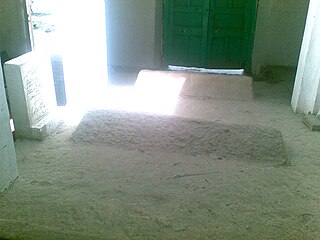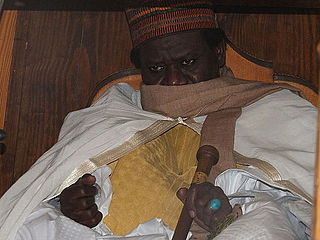Sheikh —also transliterated sheekh, sheik, sheyikh, shaykh, shayk, shekh, shaik and shaikh, shak—is an honorific title in the Arabic language. It commonly designates a chief of a tribe or a royal family member in Arabian countries, in some countries it is also given to those of great knowledge in religious affairs as a surname by a prestige religious leader from a chain of Sufi scholars. It is also commonly used to refer to a Muslim religious scholar. It is also used as an honorary title by people claiming to be descended from Hasan ibn Ali and Husayn ibn Ali both patrilineal and matrilineal who are grandsons of the Islamic prophet Muhammad. The term is literally translated to "Elder" .The word sheikh mention in surah qasas 28:23 verse of Quran.

The Safavid order, also called the Safaviyya, was a tariqa founded by the Kurdish mystic Safi-ad-din Ardabili (1252–1334). It held a prominent place in the society and politics of northwestern Iran in the fourteenth and fifteenth centuries, but today it is best known for having given rise to the Safavid dynasty. While initially founded under the Shafi'i school of Sunni Islam, later adoptions of Shi'i concepts such as the notion of the Imamate by the children and grandchildren of Safi-ad-din Ardabili resulted in the order ultimately becoming associated with Twelverism.

Rifaʽi is an eminent Sufi order (tariqa) within Sunni Islam founded by Ahmed ar-Rifaʽi and developed in the Lower Iraq marshlands between Wasit and Basra. The Rifa'iyya had its greatest following until the 15th century C.E. when it was overtaken by the Qadiri order. The order is said to wield particular influence in Cairo, Egypt.

The Qadiriyya are members of the Sunni Qadiri tariqa. The tariqa got its name from Abdul Qadir Gilani, who was a Hanbali scholar from Gilan, Iran. The order relies strongly upon adherence to the fundamentals of Sunni Islamic law.

Al-Ahbash, also known as the Association of Islamic Charitable Projects is a neo-traditionalist Sufi religious movement which was founded in the mid-1980s. The group follow the teachings of Ethiopian scholar Abdullah al-Harari. Due to the group's origins and activity in Lebanon, the Ahbash have been described as the "activist expression of Lebanese Sufism."
Haydar, also spelt Hajdar, Hayder, Heidar, Haider, Heydar, and other variants, is an Arabic male given name, also used as a surname, meaning "brave" and "lion". In Islamic tradition, the name is primarily associated with Ali, the cousin of Muhammad, who was nicknamed "Haydar".

Shaykh al-Mashāʾikh Makhdūm Shaykh Jalāl Mujarrad bin Muḥammad Kunyāī, popularly known as Shah Jalal, was a celebrated Sufi figure of Bengal. His name is often associated with the Conquest of Sylhet and the spread of Islam into the region, part of a long history of interactions between the Middle East, Turkestan, and South Asia. Various complexes and religious places have been named after him, including the largest airport in Bangladesh, Hazrat Shahjalal International Airport.
Abdullah ibn Muhammad ibn Yusuf Al-Harariyy (1906) – September 2, 2008) was a Harari muhaddith and scholar of Islamic jurisprudence. He lived and taught in Beirut, Lebanon, and was the founder of Al-Ahbash, a Sufi religious movement.
Batu Dugda is one of the districts in the Oromia Regional State of Ethiopia. Part of the Arsi Zone located in the Great Rift Valley, Batu Dugda is bordered on the south by Munesa, on the west and north by the East Shewa Zone, on the east by Hitosa, and on the southeast by Tiyo; also on its western edge is Hora-Dambal, whose area this woreda shares with the East Shewa Zone. The administrative center for this woreda is Ogolcho; other settlements include Chefe Jile, Areta Chufa, Hula Arba and Natile.

Shaykh Haydar or Sheikh Haydar was the successor of his father as leader of the Safavid order from 1460-1488. Haydar maintained the policies and political ambitions initiated by his father. Under Sheikh Haydar, the order became crystallized as a political movement with an increasingly extremist heterodox Twelver Shi'i coloring and Haydar was viewed as a divine figure by his followers. Shaykh Haydar was responsible for instructing his followers to adopt the scarlet headgear of 12 gores commemorating The Twelve Imams, which led to them being designated by the Turkish term Qizilbash "Red Head".

Hazrat Mawlana Pir Fazal Ali Shah Qureshi was an Islamic scholar and the leading Naqshbandi Shaikh of colonial India in the early twentieth century. He was born to Murad Ali Shah in 1270 AH in Daud Khel, Punjab, and died at 84 in the first night of Ramadan 1354 AH and was buried at Miskeenpur shareef, district Muzaffargarh, Punjab.

Sayyid Baha al-Din Haydar, Haydar al-'Obaidi al-Hossayni Amuli, or Sayyed Haydar Amoli or Mir Haydar Amoli a Shi'ite mystic and a Sufi philosopher, was an early representative of Persian theosophy and one of the most distinguished commentators of the mystic philosopher Ibn Arabi, during the 14th century.
Muhammad Tānī was an Ethiopian Muslim cleric, scholar, teacher and political leader.

Sheikh Ahmad Tijani Ali Cisse is the spiritual leader of the Tijaniyya Sufi order. The Tijaniyya is the largest Sufi order in Western Africa and its leader is responsible for nearly 300 million Sufi adherents.
Samad is a village in southern Syria, administratively part of the Daraa Governorate, located east of Daraa and immediately southeast of Bosra. Other nearby localities include al-Qurayya to the northeast, Hout to the east and Dhibin to the southeast. According to the Syria Central Bureau of Statistics (CBS), Samad had a population of 3,098 in the 2004 census.

ShaykhJawhar Haydar ʽAli was a mystic and Islamic scholar of Shonke, southeast Wollo, Ethiopia. He was usually referred to as the Shayk of Shonke, Shonkeyy and Abbayye.

Dana is a village located 38 km away from Weldiya town in the district of Habru, North Wollo Zone of Amhara Region, Ethiopia.
Nūr al-Hudā Abū'l-Karāmāt as-Saʿīdī al-Ḥusaynī, better known as Ḥaydar Ghāzī, was the second wazir of Srihat (Sylhet) under the various Sultans of Sonargaon and Lakhnauti. Prior to this, Ghazi took part in the Conquest of Gour in 1303.
Ahmad Zayni Dahlan (1816–1886) was the Grand Mufti of the Shafi'i madhab in Mecca, and Shaykh al-Islam in the Hijaz region of the Ottoman state, and Imam al-Haramayn, as well as being a historian and an Ash'ari theologian. He was known for his extreme criticisms of Wahhabism and his tendency toward Sufism (Mysticism). In his treatise against Wahhabi influence, Dahlan clearly views Sufism as a legal and integral part of Islamic practice – including such aspects as Tawassul, Tabarruk, and Ziyarat al-Qubur.
Shāh Muḥammad ʿAlāʼ Bakhsh was a 16th-century Bengali theologian, activist and Islamic scholar. He was the ancestor of Abdul Latif Chowdhury Fultali, a prominent Ṣūfī the 20th century.











